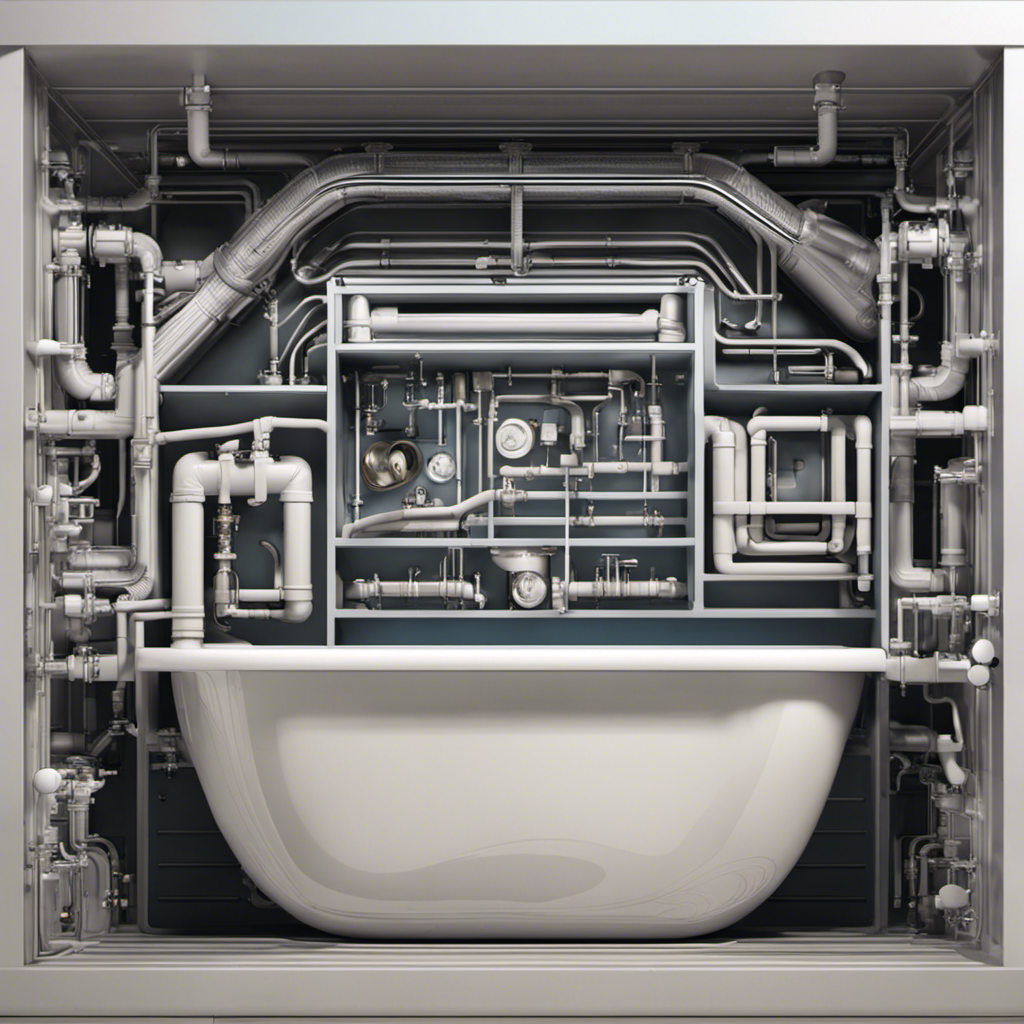I’ve always wondered how long a bathtub can actually last. Well, let me tell you, it depends on a few factors. In this article, I’ll discuss the key factors that affect a bathtub’s lifespan, the signs of wear and tear to look out for, and some maintenance tips to help extend its lifespan.
We’ll also explore the average lifespan of different bathtub materials and when it might be time to consider replacing your trusty tub.
So, let’s dive in and uncover the secrets behind bathtub longevity.
Key Takeaways
- The lifespan of a bathtub can be affected by factors such as water damage, lower-quality materials or poor installation, frequency and intensity of use, and other factors contributing to wear and tear.
- Signs of wear and tear in bathtubs include cracks, discoloration, leaks, and mold growth. Promptly addressing these issues and conducting common repairs can help extend the lifespan of a bathtub.
- Regular cleaning, proper ventilation, and cleaning drains are important maintenance tips to prevent grime, soap scum, mold buildup, and moisture accumulation, which can all impact the longevity of a bathtub.
- The average lifespan of different bathtub materials varies, with acrylic lasting 15-20 years, cast iron lasting 50+ years, and fiberglass lasting 10-15 years. Considering the material lifespan and opting for professional installation can have advantages in extending the lifespan of a bathtub.
Factors Affecting Bathtub Lifespan
There are several factors that can affect how long a bathtub lasts. As someone with years of experience in bathtub replacement and repair, I have encountered a range of common bathtub problems that can significantly impact their lifespan.
One of the most common issues is water damage. If the caulking around the tub becomes worn or damaged, water can seep into the walls and flooring, causing structural issues that may require a full bathtub replacement.
Another factor to consider is the quality of the bathtub itself. Lower-quality materials or poor installation can lead to cracks, chips, and leaks over time, reducing the bathtub’s lifespan.
Additionally, the frequency and intensity of use can also impact how long a bathtub lasts. If the tub is used daily or subjected to heavy use, it may wear out more quickly.
These factors, among others, contribute to the signs of wear and tear in bathtubs.
Signs of Wear and Tear in Bathtubs
Check for signs of wear and tear in your tub, such as cracks or discoloration. These are common issues that can affect the lifespan of your bathtub. Cracks in the tub can lead to leaks, causing water damage to your bathroom floor and walls. Discoloration may indicate mold, which can be harmful to your health if left unaddressed.
To prevent bathtub mold, properly ventilate your bathroom and wipe down the tub after each use to remove excess moisture. If you notice any signs of wear and tear, address them promptly. Common bathtub repairs include patching up cracks, refinishing the surface, or replacing damaged parts. Taking care of these issues will ensure the longevity of your bathtub.
Maintenance Tips to Extend Bathtub Lifespan
To extend the lifespan of your tub, regularly cleaning and properly ventilating your bathroom are essential maintenance tips.
Cleaning your bathtub regularly will prevent the buildup of grime, soap scum, and mold, which can cause damage over time. Use a non-abrasive cleaner and a soft cloth or sponge to gently scrub the surface of your tub. Don’t forget to clean the drains and remove any hair or debris that may clog them.
Proper ventilation is also important to prevent moisture accumulation, which can lead to mold and mildew growth. Make sure your bathroom has a functioning exhaust fan or open a window to allow fresh air to circulate.
Average Lifespan of Different Bathtub Materials
Make sure you properly maintain your bathtub by regularly cleaning and ventilating it, as the average lifespan of different bathtub materials can vary. It’s important to understand the durability and longevity of different materials before making a decision. Here is a comparison of the average lifespans for three common bathtub materials:
| Material | Average Lifespan |
|---|---|
| Acrylic | 15-20 years |
| Cast Iron | 50+ years |
| Fiberglass | 10-15 years |
As you can see, cast iron bathtubs have the longest lifespan, lasting over 50 years, while acrylic and fiberglass bathtubs have shorter lifespans of 15-20 years and 10-15 years, respectively. It’s also worth mentioning the benefits of professional installation. Professional installation ensures proper fitting and sealing, reducing the risk of leaks and potential damage to the bathtub. This can help prolong the lifespan of your bathtub and provide peace of mind. So, when choosing a bathtub material, consider both its lifespan and the advantages of professional installation.
When to Consider Replacing Your Bathtub
If you notice significant damage or staining on the surface of your bathtub, it may be time to consider replacing it. However, before you go through the hassle and expense of replacing your bathtub, there are some alternatives you can consider.
-
Bathtub Refinishing: Refinishing your bathtub can be a cost-effective solution that restores its appearance and durability. It involves removing the old finish, repairing any cracks or chips, and applying a new finish, giving your bathtub a fresh and updated look.
-
Bathtub Liners: A bathtub liner is a custom-made acrylic shell that fits over your existing bathtub. It provides a new surface that covers any damage or stains, giving your bathtub a brand-new look without the need for extensive renovation.
-
Tub and Tile Reglazing: This process involves applying a new coating to the surface of your bathtub and tiles, giving them a glossy and pristine finish. It can be a more affordable alternative to replacing your bathtub while still achieving a like-new appearance.
Considering these alternatives can help you save time and money while still giving your bathtub a much-needed makeover.
Conclusion
In conclusion, the lifespan of a bathtub varies depending on various factors such as material, usage, and maintenance. However, with proper care and regular maintenance, you can extend the life of your bathtub.
Remember to keep an eye out for signs of wear and tear and address them promptly. By following these maintenance tips, you can enjoy your bathtub for many years to come.
So, don’t hesitate to invest in a high-quality bathtub and give it the TLC it deserves!










